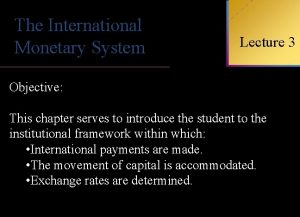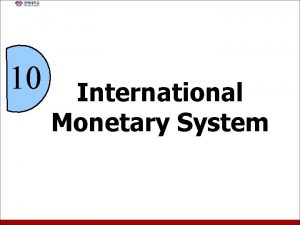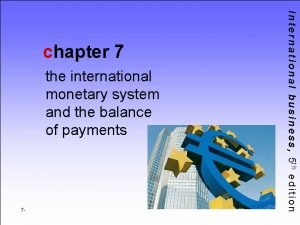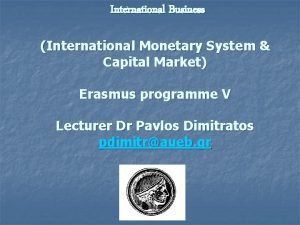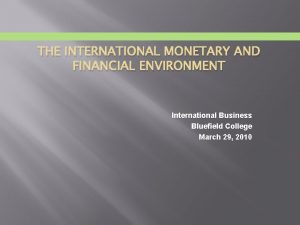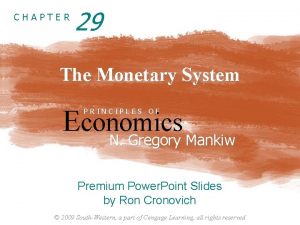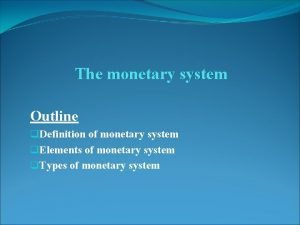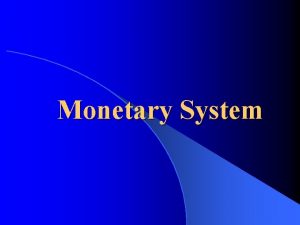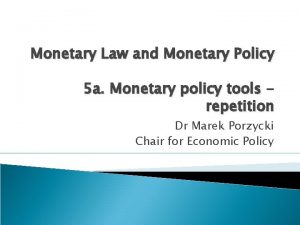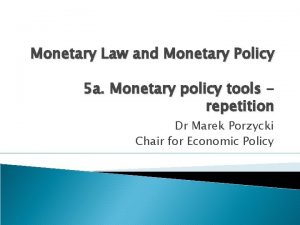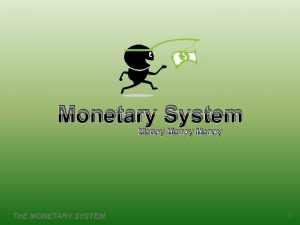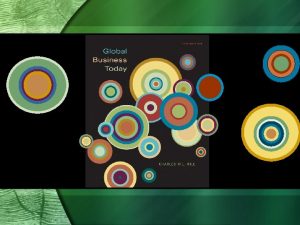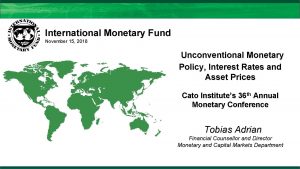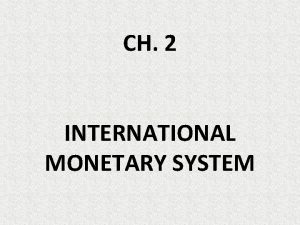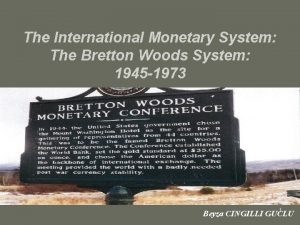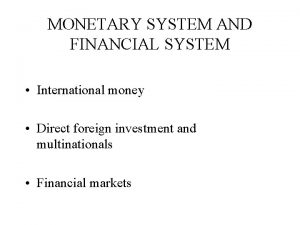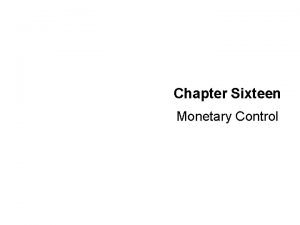The International Monetary System What is International Monetary








































- Slides: 40

The International Monetary System

What is International Monetary System Ø International Monetary System: Institutional framework within which international payments are made, movements of capital are accommodated, and exchange rates among currencies are determined. Ø A complex whole of agreements, rules, institutions, mechanisms, and policies regarding exchange rates, international payments, and the flow of capital. 2 -2 11 -2

Evolution of the International Monetary System Ø Bimetallism: Before 1875 Ø Classical Gold Standard: 1875 -1914 Ø Interwar Period: 1915 -1944 Ø Bretton Woods System: 1945 -1972 Ø The Flexible Exchange Rate Regime: 1973 -Present 2 -3 11 -3

Different Types of the International Monetary System? Ø A floating exchange rate system exists when a country allows the foreign exchange market to determine the relative value of a currency Ø A pegged exchange rate system exists when a country fixes the value of its currency relative to a reference currency Ø A dirty float exists when a country tries to hold the value of its currency within some range of a reference currency such as the U. S. dollar Ø A fixed exchange rate system exists when countries fix their currencies against each other at some mutually agreed on exchange rate 11 -4

What Was The Gold Standard? Ø The gold standard refers to a system in which countries peg currencies to gold and guarantee their convertibility Øin the 1880 s, most nations followed the gold standard Ø$1 = 23. 22 grains of “fine” (pure) gold Øthe gold par value refers to the amount of a currency needed to purchase one ounce of gold 11 -5

Why Did The Gold Standard Make Sense? Ø The great strength of the gold standard was that it contained a powerful mechanism for achieving balance-of-trade equilibrium by all countries Ø The gold standard worked well from the 1870 s until 1914 Ø but, many governments financed their World War I expenditures by printing money and so, created inflation Ø People lost confidence in the system Ø By 1939, the gold standard was dead 11 -6

Interwar Period: 1915 -1944 Ø Exchange rates fluctuated as countries widely used “predatory” depreciations of their currencies as a means of gaining advantage in the world export market. Ø Attempts were made to restore the gold standard, but participants lacked the political will to “follow the rules of the game”. Ø The result for international trade and investment was profoundly detrimental. Ø Economic nationalism, economic and political instabilities, bank failures, panicky flights of capital across borders, 1929 Great Depression, all reasons required a new system. 2 -7 11 -7

What Was The Bretton Woods System? Ø In 1944, representatives from 44 countries met at Bretton Woods, New Hampshire, to design a new international monetary system that would facilitate postwar economic growth Ø Under the new agreement Ø a fixed exchange rate system was established Ø all currencies were fixed to gold, but only the U. S. dollar was directly convertible to gold Ø devaluations could not to be used for competitive purposes Ø a country could not devalue its currency by more than 10% without IMF approval 11 -8

Bretton Woods System: Dollar based gold exchange standart 1945 -1972 German mark British pound r e a P alu V French franc Pa Va r lue Par Value U. S. dollar Pegged at $35/oz. Gold 2 -9 11 -9

What Institutions Were Established At Bretton Woods? Ø The Bretton Woods agreement also established two multinational institutions 1. The International Monetary Fund (IMF) to maintain order in the international monetary system through a combination of discipline and flexibility 2. The World Bank to promote general economic development Ø also called the International Bank for Reconstruction and Development (IBRD) 11 -10

Why Did The Fixed Exchange Rate System Collapse? Ø Bretton Woods worked well until the late 1960 s Ø It collapsed when huge increases in welfare programs and the Vietnam War were financed by increasing the money supply and causing significant inflation Ø other countries increased the value of their currencies relative to the U. S. dollar in response to speculation the dollar would be devalued Ø However, because the system relied on an economically well managed U. S. , when the U. S. began to print money, run high trade deficits, and experience high inflation, the system was strained to the breaking point Ø the U. S. dollar came under speculative attack 11 -11

Nixon Ends Bretton Woods International Monetary System Ø https: //www. youtube. com/watch? v=i. Rzr 1 Q U 6 K 1 o Ø https: //youtu. be/i. Rzr 1 QU 6 K 1 o 11 -12

What Was The Jamaica Agreement? Ø A new exchange rate system was established in 1976 at a meeting in Jamaica Ø The rules that were agreed on then are still in place today Ø Under the Jamaican agreement Ø floating rates were declared acceptable Ø gold was abandoned as a reserve asset Ø total annual IMF quotas - the amount member countries contribute to the IMF - were increased to $41 billion – today they are about $300 billion 11 -13

What Has Happened To Exchange Rates Since 1973? Ø Since 1973, exchange rates have been more volatile and less predictable than they were between 1945 and 1973 because of Øthe 1971 and 1979 oil crises Øthe loss of confidence in the dollar after U. S. inflation in 1977 -78 Øthe rise in the dollar between 1980 and 1985 Øthe partial collapse of the EMS in 1992 Øthe 1997 Asian currency crisis Øthe decline in the dollar from 2001 to 2009 11 -14

What Has Happened To Exchange Rates Since 1973? Major Currencies Dollar Index, 1973 -2010 11 -15

Crises Have Common Underlying Causes Ø Common causes: ØHigh inflation ØWidening current account deficit ØExcessive expansion of domestic borrowing ØAsset price inflation © Mc. Graw Hill Companies, Inc. , 2000 10 -22 11 -16

The Mexican Peso Crisis Ø On 20 December, 1994, the Mexican government announced a plan to devalue the peso against the dollar by 14 percent. Ø This decision changed currency trader’s expectations about the future value of the peso. Ø Early 1995 the peso fell against the US dollar by as much as 40 percent. 2 -17 11 -17

The Mexican Peso Crisis of the Mid-1990 s Ø https: //youtu. be/h. TWLEhlq 1 c. Q Ø https: //www. youtube. com/watch? v=h. TWL Ehlq 1 c. Q 11 -18

The Mexican Peso Crisis (1994) Ø This is the first cross border flight of portfolio capital: International mutual funds investment before crises were 54 billion dollar !!! Ø In a system like this: Ø 1. Having multinational safety net in place to safeguard the world financial system is important. Ø 2. Foreign capital influx causes a higher domestic inflation and overvalued money, that hurts trade balances. 2 -19 11 -19

The Asian Currency Crisis (1997) Ø The Asian currency crisis turned out to be far more serious than the Mexican peso crisis in terms of the extent of the contagion and the severity of the resultant economic and social costs. Ø Many firms with foreign currency bonds were forced into bankruptcy. Ø The region experienced a deep, widespread recession. 2 -20 11 -20

The Asian Currency Crisis Ø Weak domestic financial system, free international capital flows, contagion effects of changing market sentiment (feeling), inconcistent economic policies are all the factors behind the Asian Currency Crises. Ø The liberalisation cause the Asian countries inflow of foreign capital. Credit boom directed to speculation on real 2 -21 estate, stock market. 11 -21

The Asian Currency Crisis Ø Fixed or stable exchange rates encourage unhedged financial transactions and excessive risk taking by lenders/borrowers. Ø Asset prices declined, than quality of banks’ loan portfolios (collateral) Ø Crony capitalism is not new for Asia too. (poor risk managemend and supervision, political influence, suboptimal allocation of resources. . . ) 2 -22 11 -22

The Asian Currency Crisis Ø Booming economy with a fixed or stable nominal exchange rate inevitably brought about an appreciation of the real exchange rate. Caused in a marked slowdown in export growt. Ø Yen’s depreciation against the dollar hurt Japan’s neighbours more. Ø Panickly flight of capital from the Asian countries cause the crisis to become extended. Ø IMF intervention 2 -23 11 -23

Lessons from Asian Currency Crisis Ø Countries first strengthen their domestic financial system and then liberalize their financial markets. Ø Financial sector regulations and supervision is the most important. Basel Committee on Banking Supervision rules. . . Ø Encourage foreign direct investment and equity and long term bond investment discourage short term investment even by using Tobin tax Ø “incompatible trinity” or “trilemma” a country can attain only two of the following three conditions: 1. a fixed exchange rate system 2. free international flows of capital 3. an independent monetary policy. 2 -24 11 -24

WHERE THE MONEY WENT? FROM ASIA TO… ? ? ? ? ? 11 -25

Russia- New emerging market Ø Financial markets loss of confidence in Russia’s ability to meet national and international payments. ØLed to loss of international reserves and roll over of treasury bills reaching maturity. Ø Financial markets unable to determine ‘who’s in charge’. © Mc. Graw Hill Companies, Inc. , 2000 10 -30 11 -26

Government Actions Exacerbating the Situation Ø Defacto devaluation of the ruble. Ø Unilateral restructuring of rubledenominated public debt. Ø 90 -day moratorium on foreign credits repayment. Ø Hike in interest rates to defend ruble. Ø Duma rejects measures designed to alleviate problems. © Mc. Graw Hill Companies, Inc. , 2000 10 -31 11 -27

Russian Rubles to US Dollar © Mc. Graw Hill Companies, Inc. , 2000 10 -32 11 -28

Russia Real GDP © Mc. Graw Hill Companies, Inc. , 2000 10 -33 11 -29

Recalling recession: 10 years on from Russian crisis Ø https: //www. youtube. com/watch? v=GJ UArc. O 18 GM Ø https: //youtu. be/GJUArc. O 18 GM 11 -30

The Argentinean Peso Crisis (2002) Ø In 1991 the Argentine government passed a convertibility law that linked the peso to the U. S. dollar at parity. (currency board) Ø The initial economic effects were positive: ØArgentina’s chronic inflation was curtailed (limited) ØForeign investment poured in Ø As the U. S. dollar appreciated on the world market the Argentine peso became stronger as well. 2 -31 11 -31

The Argentinean Peso Crisis Ø The strong peso hurt exports from Argentina and caused a protracted (extended) economic downturn that led to the abandonment of peso–dollar parity in January 2002. ØThe unemployment rate rose above 20 percent ØThe inflation rate reached a monthly rate of 20 percent 2 -32 11 -32

The Argentinean Peso Crisis Ø There at least three factors that are related to the collapse of the currency board arrangement and the ensuing economic crisis: ØLack of fiscal discipline ØLabor market inflexibility ØContagion from the financial crises in Brazil and Russia Ø Argentina refused to pay its debts and offered to pay only %25 of NPV of the 2 -33 11 -33

Currency Crisis Explanations Ø In theory, a currency’s value mirrors the fundamental strength of its underlying economy, relative to other economies. In the long run. Ø In the short run, currency trader’s expectations play a much more important role. Ø In today’s environment, traders and lenders, using the most modern communications, act by fight-or-flight instincts. For example, if they expect others are about to sell Brazilian currency for U. S. dollars, they want to “get to the exit first”. Ø Thus, fears of depreciation become self-fulfilling prophecies. 2 -34 11 -34

Which Is Better – Fixed Rates Or Floating Rates? Ø Floating exchange rates provide 1. Monetary policy autonomy 2. Automatic trade balance adjustments Ø But, a fixed exchange rate system 1. Provides monetary discipline 2. Minimizes speculation 3. Reduces uncertainty 11 -35

What Type of Exchange Rate System Is In Practice Today? Ø Various exchange rate regimes are followed today Ø Ø 14% of IMF members follow a free float policy 26% of IMF members follow a managed float system 22% of IMF members have no legal tender of their own the remaining countries use less flexible systems such as pegged arrangements, or adjustable pegs Ø Countries with a pegged exchange rate system peg the value of its currency to that of another major currency Ø Countries using a currency board commit to converting their domestic currency on demand into another currency at a fixed exchange rate Ø No national currency Ø Some countries do not bother printing their own currency. For example, Ecuador, Panama, and El Salvador have dollarized. Montenegro and San Marino use the euro. 11 -36

What Type of Exchange Rate System Is In Practice Today? Exchange Rate Policies of IMF Members 11 -37

What Is The Role Of The IMF Today? Ø Today, the IMF focuses on lending money to countries in financial crisis Ø There are three types of financial crises: 1. A currency crisis Ø Brazil 2002 2. A banking crisis 3. A foreign debt crisis Ø Greece and Ireland 2010 11 -38

How Has The IMF Done? Ø By 2010, the IMF was making loans to 68 countries all of which require tight macroeconomic and monetary policy Ø However, critics worry Ø the “one-size-fits-all” approach to macroeconomic policy is inappropriate for many countries Ø the IMF is exacerbating moral hazard Ø the IMF has become too powerful for an institution without any real mechanism for accountability Ø However, in recent years, the IMF has started to change its policies and be more flexible Ø urged countries to adopt fiscal stimulus and monetary easing policies in response to the 2008 -2009 global financial crisis 11 -39

What Does The Monetary System Mean For Managers? Ø Managers need to understand how the international monetary system affects 1. Currency management - the current system is a managed float - government intervention can influence exchange rates 2. Business strategy - exchange rate movements can have a major impact on the competitive position of businesses 3. Corporate-government relations - businesses can influence government policy towards the international monetary system 11 -40
 International monetary system
International monetary system Objectives of international monetary system
Objectives of international monetary system International monetary system
International monetary system International monetary system
International monetary system International monetary fund apush
International monetary fund apush International monetary and financial environment
International monetary and financial environment International financial environment
International financial environment International monetary fund
International monetary fund International monetary fund
International monetary fund Chapter 29 the monetary system answers
Chapter 29 the monetary system answers Meaning of monetary system
Meaning of monetary system Hát kết hợp bộ gõ cơ thể
Hát kết hợp bộ gõ cơ thể Bổ thể
Bổ thể Tỉ lệ cơ thể trẻ em
Tỉ lệ cơ thể trẻ em Voi kéo gỗ như thế nào
Voi kéo gỗ như thế nào Tư thế worms-breton
Tư thế worms-breton Hát lên người ơi
Hát lên người ơi Các môn thể thao bắt đầu bằng từ đua
Các môn thể thao bắt đầu bằng từ đua Thế nào là hệ số cao nhất
Thế nào là hệ số cao nhất Các châu lục và đại dương trên thế giới
Các châu lục và đại dương trên thế giới Công thức tính thế năng
Công thức tính thế năng Trời xanh đây là của chúng ta thể thơ
Trời xanh đây là của chúng ta thể thơ Mật thư tọa độ 5x5
Mật thư tọa độ 5x5 Phép trừ bù
Phép trừ bù độ dài liên kết
độ dài liên kết Các châu lục và đại dương trên thế giới
Các châu lục và đại dương trên thế giới Thể thơ truyền thống
Thể thơ truyền thống Quá trình desamine hóa có thể tạo ra
Quá trình desamine hóa có thể tạo ra Một số thể thơ truyền thống
Một số thể thơ truyền thống Cái miệng xinh xinh thế chỉ nói điều hay thôi
Cái miệng xinh xinh thế chỉ nói điều hay thôi Vẽ hình chiếu vuông góc của vật thể sau
Vẽ hình chiếu vuông góc của vật thể sau Nguyên nhân của sự mỏi cơ sinh 8
Nguyên nhân của sự mỏi cơ sinh 8 đặc điểm cơ thể của người tối cổ
đặc điểm cơ thể của người tối cổ Thế nào là giọng cùng tên? *
Thế nào là giọng cùng tên? * Vẽ hình chiếu đứng bằng cạnh của vật thể
Vẽ hình chiếu đứng bằng cạnh của vật thể Tia chieu sa te
Tia chieu sa te Thẻ vin
Thẻ vin đại từ thay thế
đại từ thay thế điện thế nghỉ
điện thế nghỉ Tư thế ngồi viết
Tư thế ngồi viết
